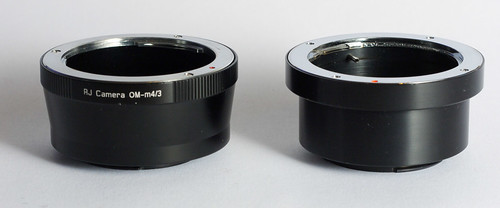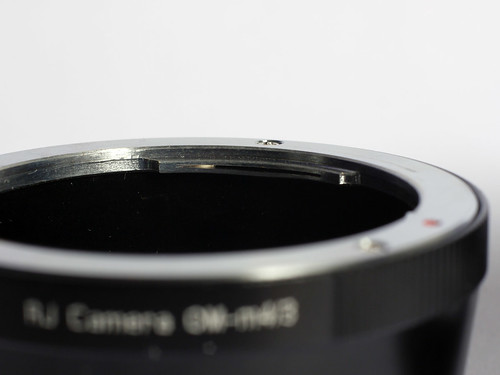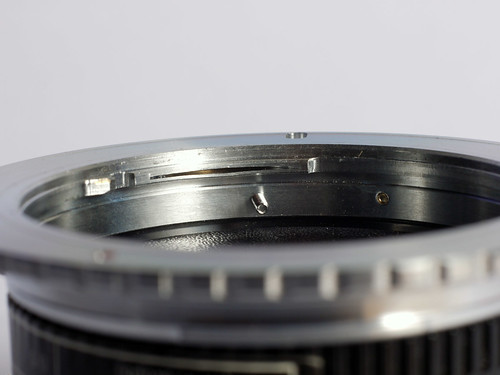Back a few months ago there was only a few options for adaptors for OM lenses (this is before Olympus brought out their E-P1 camera and OM adaptor) Essentially at that time there was only the adaptor by a fellow in Polland who sells on eBay under the name Ciecio7. Another seller jinfinance who sells the RJ Camera adaptor had some other mounts but if you wanted OM you had to buy a set which was a base micro 4/3 to 4/3 adaptor and then add onto that an adaptor from 4/3 to your mount. This meant you needed to sandwich 2 adaptors between lens and camera which I felt would be 'shakey'
I bought the Ciecio7 adaptor. At that time I wrote this review, and identified a few minor issues with the adaptor.
So, now that I have the RJ camera adaptor (and used it for some time) I thought I would make a quick comparison.
Personally I would like very much to see what he has done with development of this mount but i tseems he no longer sells it. So this review is perhaps better focused on only the RJ Camera adaptor.
Clearly the first thing which one observes is that the RJ Camera adaptor is bulk made and the Ciecio7 one hand made. If you have been involved with engineering much you'll noitce that some detail things just can't be done effectively unless doing stuff in bulk and using computer lathes with complex layups.
That's interesting as the RJ Camera adaptor is more expensive than the Ciecio7 one despite the amount of hand work done on the Ceicio7 one.

Now, its important to remember that an adaptor is just a simple bit of tube designed to:
- hold the older legacy lens at a distance further away than the mount on the camera would do
- have a physical design to match the shapes of the legacy system at one end, and the micro 4/3 on the other end.
Now, most cameras have a little spring to add tension to the mount like this:

this allows some tolerance in the small gap you'll see in the back of the lens mount system and pull it snugly onto the mount.
Just how this is solved is an important part of the system. RJ camera solves this by a cunningly placed precision slice being made in the metal and then it butterflied out.

Notice that little slice in the metal up there? Seems this is a common 'strategy' in China, as an OM to EOS mount I have:

uses a similar strategy.

The strategy employed by Ciecio7 is rather different, he makes a nick in the flange and bends the entire flange down as can be seen here.

He has said to me that he used an extension tube (I thought Vivitar) as his template, and looking at my OM mount Vivitar extension tube set I see exactly the same strategy.

When I first got the Ciecio7 adaptor it had a bend similar to the Vivitar above ...

but yet was so damn tight I could barely move the lens on and off the mount. I've used OM cameras and lenses for many many years ... so this is not simply a case of me not being used to them. In the photo above I had removed the chrome plate from the adaptor and sat it on an up-side-down lens on the mount so I could see carefully the amount of spring tension the bent bit was applying.
I carefully 'polished down' this surface to make the effective tension less...

This worked wonders and with my hand finishing of the hand made adaptor mentioned in the article above the Ciecio7 adaptor worked beautifully.
However the RJ adaptor despite looking nice has some small issues as well, it barely has any tension on the mounted lens. Despite having a similar cunning strategy
Look carefully at the amount of space in the splits:

The lower portion of the image is the adaptor for mounting OM onto EOS cameras. From this image you can see you can see that the gap (which is hand made by inserting a tool into the slit and bending it wider) is larger on the lower one. This makes the "fit" of the OM lens on this adaptor much nicer than that on the other one.
Conclusion?
essentially none of the OM adaptors I have are as good as the system which the OM cameras have natively. I don't know if either of the two methods is "superior" as clearly the Vivitar (system used by Ciecio7) has worked when Vivitar made it, but the issues found with that adaptor demonstrate how there must be issues of manufacture with that method (perhaps materials).
The RJ Camera adaptor is not without fault either, and again the requirement of hand tensioning that gap in the butterflying of the mount metal is crucial ...
Essentially both require a little bit of accomodation and understanding in the users. I think this is actually quite a reasonable expectation, as these things should by nature be appealing to the enthusiast and those who have "some" compentency with their hands.
If reading this has put you off buying one of these adaptors, then perhaps look to the Olympus made one, or the Rayqual one ... both of which are much more expensive but may have better quality (I don't know as I don't have one).








No comments:
Post a Comment